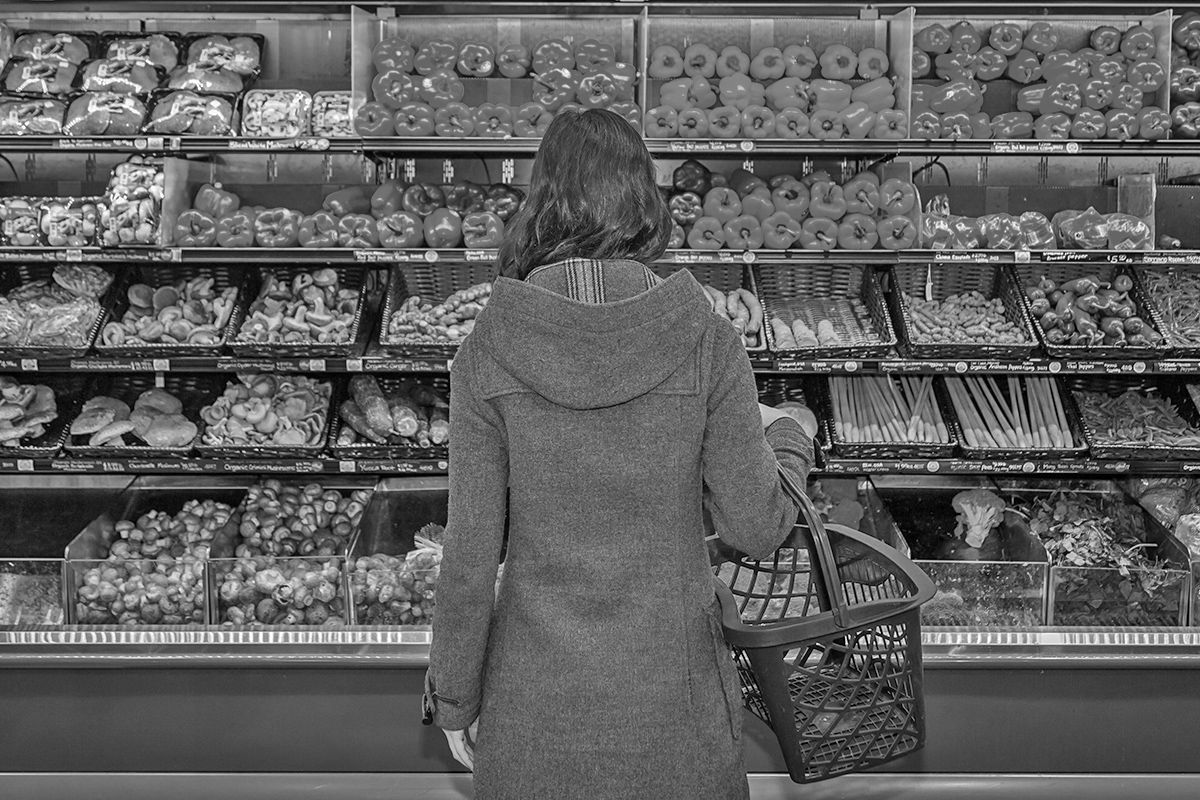The typical American grocery store carries 40,000–50,000 items, including hundreds of fruits and vegetables. Those photogenic displays of dew-kissed leafy greens, pyramids of shiny apples, and baskets of sun-kissed lemons are carefully organized, of course, to entice shoppers into purchasing them. Let’s investigate some secrets of the produce aisle below.
Original photo by Adam Melnyk/ Shutterstock
Bananas Should Be Yellow, but Not Just Any Yellow

The bananas you see at the grocery store are Cavendish bananas — a cultivar that the banana industry adopted in the 1950s after a tropical fungus wiped out an earlier variety. Growers produce more than 60.6 million tons of Cavendish bananas every year for export all over the world. The bananas are prized for their sweetness, creamy texture, and appealing bright-yellow skin.
Stores buy unripe green bananas from growers so that by the time the fruit hits grocery store shelves, it has ripened to its more well-known yellow shade. Marketing expert Martin Lindstrom has written that bananas matching Pantone 12-0752 TPX Buttercup — a warm, inviting yellow — tend to sell better than bananas in Pantone 13-0858 TCX Vibrant Yellow, just one shade cooler.
Misting Produce Is a Clever Way To Make You Buy More

Many grocery stores display produce in open cases fitted with tiny jets to periodically bathe the veggies in a cool mist. (Some supermarkets even pipe in the sound of thundering rain to add to the rainy vibe.) The purpose behind misting is not to keep produce clean or extend its shelf life — it’s a clever way for grocers to make the fruits and vegetables look fresher and healthier so consumers purchase more. Water clinging to leafy greens also adds weight, which increases revenue for the store when vegetables are sold by the pound.
Ironically, misting actually shortens produce’s shelf life because water allows bacteria and mold to take hold. Misted veggies will likely not last as long in your fridge as those that weren’t misted in the produce aisle — which is another, perhaps sneakier, way to get you to buy produce more often.
Brussels Sprouts, Broccoli, and Kale Are All Subspecies of the Same Plant

A surprising number of veggies in the produce aisle are the same species, Brassica oleracea — but you wouldn’t know it by looking at them. Brussels sprouts, broccoli, cauliflower, kale, collard greens, purple and green cabbage, and kohlrabi are all domesticated cultivars of wild cabbage, a plant native to western and southern Europe. For the last few thousand years, farmers have selectively bred the wild plant to augment some part of its form, such as the leaves, buds, or stems. Today, each cultivar is classified as a subspecies of B. oleracea.
Some Popular Nuts Are Not Actually Nuts

Botanically speaking, a nut is a fruit with a hard shell containing a single seed. The true nuts you might encounter in the produce aisle include hazelnuts and chestnuts. Many of the products sold as “culinary nuts” belong to other botanical classifications. Cashews, almonds, and pistachios are known as “drupes,” a type of fruit with thin skin and a pit containing the seed. (Peaches, mangos, cherries, and olives are also drupes.) And the jury is still out on whether walnuts and pecans fall into the nut or drupe category since they have characteristics of both. Some botanists call them drupaceous nuts.
The Produce Industry Has a Special Lingo

Like any business, the produce industry has its own slang, describing everything from a cosmetic flaw in a tomato (“catfacing”) to the practice of hiding some less-than-ideal specimens in a box of otherwise fresh fruit (“stovepiping”). In produce slang, veggies “with legs” are those that have a longer shelf life than those that require special handling and rotation on the display. A flawless fruit, whether it’s a peach, pear, or pineapple, is a “diamond.” A quality cantaloupe will exhibit a “full slip” on the blossom end, meaning it separated easily from the vine when it was picked, indicating the best flavor.
